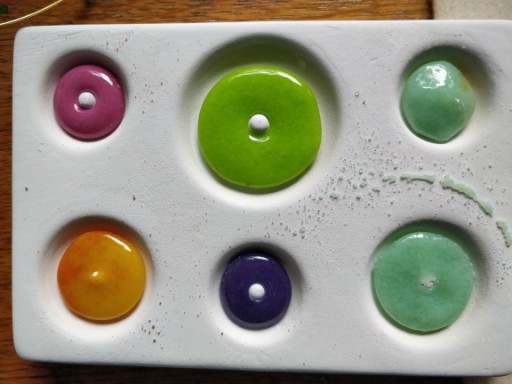Lemme just say that the text of this is basically for my reference later on and is boring, boring, boooooorinnnnnnnnnnnnnng —so mebbe look at the picture, read the caption and move on? That's pretty much the gist, anyway.
Upon discovering my fondness for pi focals, a local fuser kindly loaned me one of her Colour de Verre donut molds (what they call a simple bead mold) and the extemely expensive can of boron nitride spray release with which to coat said mold. —That was sometime in, um, February? At any rate, there was snow on the ground.

Fail. Well, almost. The pink donut is actually usable, and the purple one almost is. You can easily see the order in which I filled the molds, from neatest to sloppiest: upper left, lower centre, upper center, lower left, upper right,lower right...
A normal person, given this opportunity, would have tried it out that night. Naturally, I let it sit for two months or more. First, I had to read up on how to use the pricey spray. Oh, and find a source of the molds, in case I ruined it, so I could replace it. Then I plowed through the company's tutorials, realized I was gonna have to (eep) re-program my kiln (for probably the first time in about, oh, say 10 or 15 years) and really, that spray should be used outside. With a respirator. (The last time I changed the filters on mine was in 2016...)
However, the weather finally warmed up. I felt good, and was out of excuses for procrastinating. —As it happens, I have a cue sheet taped to the back side of my hood that not only documents the schedules currently programmed into the kiln, but also instructions for adding more.[1]
The instructions for the mold recommend 7, 9, and 17 grams respectively for the small, medium and large donuts, but in practice I was unable to fill the molds with that much of the fine, bullseye frit I had on hand. Moreover, as the filling progressed, so did my impatience and sloppiness.
Part of my problem was that my gram scale varied over time by as much as 4/10 g, which made calculations unnecessarily complicated. For example, for the top/rear left (pink) depression I had a total weight of 42.4, less 35.5g for the pewter dish, leaving me with 6.9 g of glass. After placing as much of the glass as possible as seemed reasonable in the depression, I was left with a weight of 36.9g, less 35.3 g (not .2g weight change) of the container, for a leftover of 1.6 g not used, meaning, 5.3 g total.
I did the purple (middle bottom/front) depression I had 42.3 - 36.9 for “5.4 g used” (I.e. 36.9 - 35.1 yielded 1.7 x-tra...)
Next I did the top/rear middle large depression, cutting up and using approximately .1 g of 1mm black stringer, which I carefully lay in the bottom of the mold with tweezers. Then I carefully dribbled approximately 10g and then 5gm more of lime frit. (I added exactly 10g the first time, and used it all—no notes—and then 40.4-35.2 yielded approximately 5g more.)
By the time I did the mixed yellow donut, I simply noted down 5 dk, 4 lt yellow; and the mixed green and yellow notes there is 1.5g yellow; and for the mint green one I simply eyeballed it. I also got progressively sloppier about smoothing and packing the frit (I had on an inexpensive pair brown cotton gloves, so was not touching either the frit or the mold release directly.)
Recommendations for next time: use the waxer's trick of a piece of nylon stocking to smooth mold; carefully arrange frit, possibly with paintbrush in addition to (gloved) finger tip, particularly with regards to shaping a v-shaped depression or groove around post and perimeter; and put any decorative stringer, etc on the top, not first (unless design is desired for back of piece.)
Fusing schedule.
I used the schedule recommended by the company, and was it ever slooooowww...this is definitely an activity to do at bedtime, so the kiln has all night to do its thing. This is only a two segment schedule, so it does have the benefit of being super simple.
- Cont; 300F/hr; 1440F; 35minute soak;
- Conr; Full; 960F; 30 minute soak; (end)
- crashed the kiln a little by opening precisely at end of 1st soak. Otherwise, let it do its thing.
N.b.: both temperatures (and, presumably, glass weights) are geared for 96 COE—nominally 1420 and 960 recce'd, with a 20F deg increase for casting temperature.
[1]At some point, my spouse will building a controller for my other kiln, which I plan to dedicate to fusing...
Unless otherwise noted, text, image and objects depicted therein copyright 1996--present sylvus tarn.
Sylvus Tarn